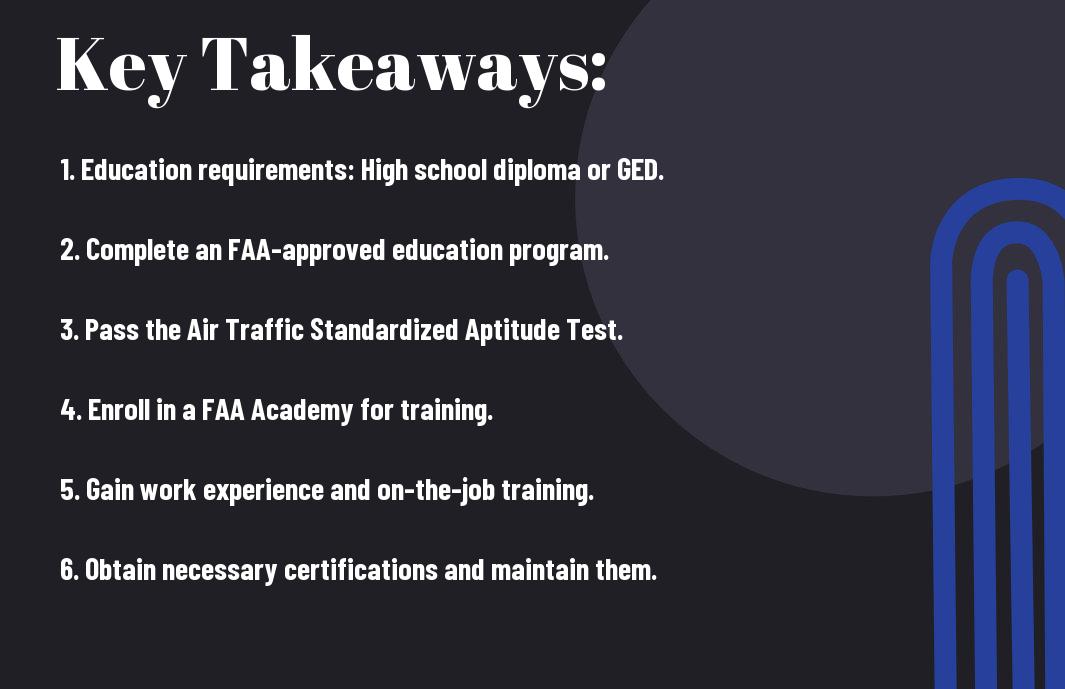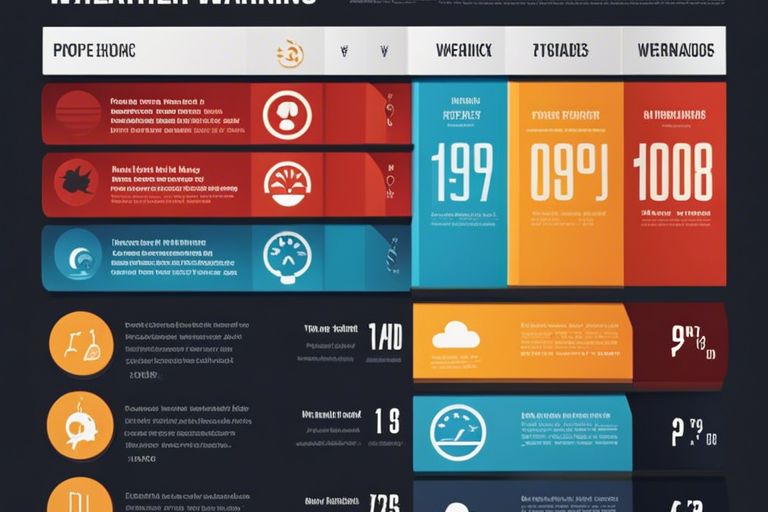Embarking on a career as an air traffic controller can be a challenging yet incredibly rewarding endeavor. As an essential part of the aviation industry, air traffic controllers are responsible for safely guiding aircraft through the skies and managing air traffic flow. If you have a passion for aviation, excellent communication skills, and the ability to work well under pressure, this may be the perfect career for you. In this career path guide, I will outline the steps and requirements for becoming an air traffic controller, as well as provide insights into the job’s demands, responsibilities, and opportunities for advancement. I understand the allure of this career, and with the right guidance, I can help you navigate the path to becoming a successful air traffic controller.
Key Takeaways:
- Education and Training: Becoming an air traffic controller typically requires a 2- or 4-year degree in aviation, air traffic management, or related field. Additionally, candidates must complete specialized training programs approved by the Federal Aviation Administration (FAA).
- Physical and Mental Requirements: Air traffic controllers must meet specific medical and psychological standards, as well as pass a pre-employment test. Strong communication and decision-making skills are also essential for success in this career.
- Career Progression: Entry-level air traffic controllers often start as developmental controllers and go through a rigorous training program. With experience, they can advance to positions with more responsibility, such as radar and tower controllers, or even management roles.
- Work Environment: Air traffic controllers typically work in control towers, radar centers, or en-route centers. The job often requires irregular hours, including night shifts, weekends, and holidays. It can also be high-stress, as controllers must make quick decisions to ensure the safety of air travel.
- Job Outlook and Salary: The demand for air traffic controllers is expected to grow in the coming years, providing ample job opportunities. The median annual wage for air traffic controllers is significantly higher than the national average, making it a lucrative career choice for those who meet the necessary qualifications.
The Role of an Air Traffic Controller
Before I delve into the steps on how to become an air traffic controller, it’s important to understand the role and responsibilities that come with this career. I found a great resource on how to become an air traffic controller which provides detailed insights into the profession.
Job Duties and Responsibilities
As an air traffic controller, my primary responsibility would be to ensure the safe and efficient movement of air traffic in controlled airspace. This includes issuing takeoff and landing instructions to pilots, providing weather and air traffic information to aircraft, and alerting emergency services in case of an aircraft emergency. I would also be required to manage and coordinate the flow of air traffic within designated airspace and on the ground at airports.
Required Skills and Qualifications
To excel in this role, I would need to possess strong communication and decision-making skills. The ability to stay calm under pressure and multitask effectively is crucial, as well as having a sharp attention to detail and good spatial awareness. Additionally, a bachelor’s degree in aviation, air traffic management, or a related field is typically required. Obtaining the necessary certifications and licenses, such as the Air Traffic Collegiate Training Initiative (AT-CTI) program, is also essential for a successful career as an air traffic controller.
Education and Training
If you’re considering a career as an air traffic controller, it’s important to understand the education and training required for this profession. To offer you a comprehensive guide, I highly recommend checking out this resource on Glassdoor: How to Become an Air Traffic Controller: Complete Career Path Guide.
Academic Requirements
To become an air traffic controller, a strong educational background is essential. Most candidates are required to have completed a bachelor’s degree program from an accredited institution. While the specific field of study is not always specified, degrees in aviation, air traffic management, or a related field can be particularly beneficial. Additionally, a solid understanding of mathematics, physics, and computer science is crucial for success in this career.
Air Traffic Controller Training Programs
Once you’ve met the academic requirements, the next step is to undergo specialized air traffic controller training. This involves completing a Federal Aviation Administration (FAA)-approved education program, such as the Air Traffic Collegiate Training Initiative (AT-CTI). These programs are designed to provide aspiring air traffic controllers with the knowledge and skills necessary to succeed in this fast-paced and high-pressure profession. Training typically covers topics such as aviation regulations, air traffic control procedures, and radar equipment operation. Upon completion of the program, candidates must also pass the FAA’s pre-employment tests and medical examinations to become certified air traffic controllers.
In conclusion, the path to becoming an air traffic controller involves a combination of rigorous academic study and specialized training programs. With a strong foundation in relevant academic disciplines and comprehensive training, you can set yourself up for a successful and rewarding career in air traffic control. However, it’s important to recognize that this profession comes with its own set of challenges and demands, so it’s crucial to stay informed and prepared for the demands of the job.

Career Path and Advancement Opportunities
Unlike many careers, becoming an air traffic controller does not necessarily require a specific degree. However, to become an air traffic controller, you must complete a Federal Aviation Administration (FAA) approved education program. This program can be completed through a college or technical school that offers air traffic control courses. Once you have completed the program, you must pass the FAA’s pre-employment test and the Air Traffic Selection and Training exam to be considered for employment.
Entry-level Positions
Entry-level positions in air traffic control typically start with on-the-job training and certification. As an entry-level air traffic controller, you will be responsible for directing and monitoring aircraft within your designated airspace. This includes issuing takeoff and landing instructions, providing aircraft with information about weather conditions, and maintaining communication with pilots. This role is crucial to the safety and efficiency of air travel, and it requires strong decision-making skills and the ability to remain calm under pressure.
Advancement to Senior Air Traffic Controller
Advancing to a senior air traffic controller position typically requires several years of experience and a strong performance record. As a senior air traffic controller, you may have the opportunity to take on additional responsibilities, such as training and supervising junior controllers, or specializing in a specific type of air traffic control, such as radar or tower control. This role also comes with increased responsibility and the need for strong leadership and communication skills.

Conclusion: How Do You Become an Air Traffic Controller? Career Path Guide
Presently, I have provided you with a comprehensive guide on the career path to becoming an air traffic controller. From educational requirements to training and certification, we have covered all the important steps you need to take to pursue this career. It is essential to stay focused and dedicated throughout the process, as it is a demanding and highly responsible profession. By following the steps outlined in this guide, you can set yourself on the right path to achieving your goal of becoming an air traffic controller. Remember to stay informed about any changes or updates in the field, and continue to pursue opportunities for professional development to excel in this challenging yet rewarding career.
FAQ
Q: What are the educational requirements to become an air traffic controller?
A: To become an air traffic controller, you will need to complete a bachelor’s degree in aviation, air traffic management, or a related field from an accredited institution.
Q: What training is required to become an air traffic controller?
A: After completing the required education, candidates must also complete an air traffic control training program approved by the Federal Aviation Administration (FAA).
Q: What skills are essential for a career as an air traffic controller?
A: Air traffic controllers must possess excellent communication, decision-making, and problem-solving skills. They also need to have the ability to work well under pressure and remain calm in high-stress situations.
Q: Are there any specific physical or medical requirements to become an air traffic controller?
A: Yes, candidates must meet specific medical and physical standards set by the FAA. These standards ensure that air traffic controllers are able to perform their duties safely and effectively.
Q: What is the career outlook for air traffic controllers?
A: The demand for air traffic controllers is expected to remain steady in the coming years. However, competition for positions may be strong, so it is essential for candidates to have a strong educational background and relevant experience in the field.









Leave a comment